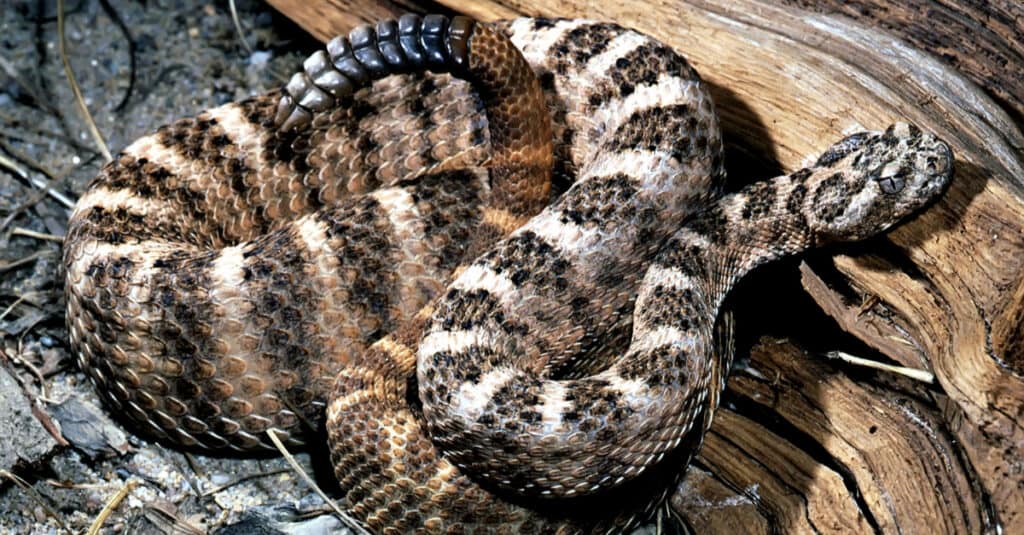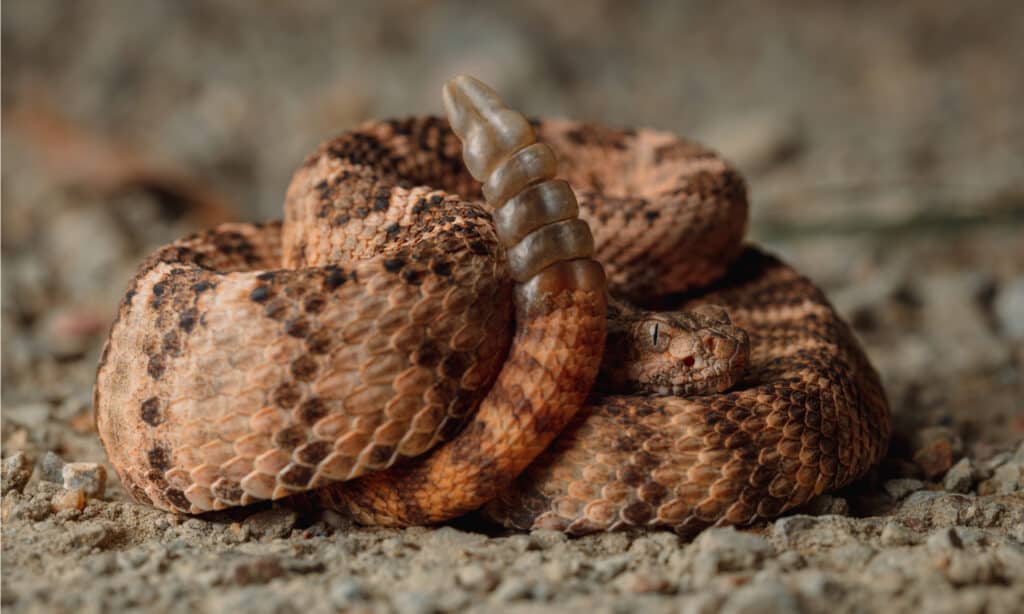The sound of a rattlesnake’s rattle is enough to send chills up your spine. Anyone that shares a locale with these deadly snakes knows that sound means to stop, examine your surroundings, and start moving away. While scary, that sound has saved lives in the past, giving people enough time to realize they’re too close to the dangerous animal. Today, we’re going to examine the rattlesnake’s rattle. We’ll answer, when do rattlesnakes lose their rattles? Also, we’ll tell you what they’re made of and more!
When Do Rattlesnakes Lose Their Rattles?

We should all collectively hope that rattlesnakes keep their rattles and do not evolve to be silent
©reptiles4all/Shutterstock.com
Rattlesnakes can lose a part of their rattle at any time. They do not shed their rattles the same way they shed their skin, though. Predation attempts are a way that rattlesnakes can lose their rattles. This can happen any time when the snake is basking, and it can happen several times a year.
Snakes’ bodies are rather tough, so they probably do not lose their rattles as a result of the terrain very often. Snakes with deformities may not develop rattles at all. However, they may also have kinked tails or limited rattle development.
Thus, there is no prescribed time for how often rattlesnakes lose their rattles. Still, it’s reasonable to say that the longer a rattlesnake lives, the greater the chances it will lose a section of its rattle.
A rattlesnake can permanently lose its rattle if it is attacked and suffers an injury at the beginning of the rattle. When that happens, the rattle may never regrow on the snake, and the animal will be left with a blunt tail. Such an injury could make it very hard to identify a rattlesnake, increasing the level of danger faced by people that encounter the snake.
What Are Rattlesnake Rattles Made Of?

The rattles of a rattlesnake are made of hard, interlocking sections of protein
©Vladislav T. Jirousek/Shutterstock.com
Rattlesnake rattles are specialized scales made of keratin, the same protein that is found in human fingernails and hair. These specialized, hollowed scales are interlocking rings of the keratin, and they are quite hard. Every segment grows inside of the one in front of it, and they’re kept in place by the segment behind them up to the tail.
Muscles near the snake’s rattle cause the segments to move, and they move very fast. In fact, the muscles controlling a rattlesnake’s rattle activate about fifty times per second! The result is a loud buzzing, rattling noise that persists for a long time, usually until the snake is left alone. When aggravated, the snake can rattle its tail for hours on end.
How Often Do Rattlesnakes Add to Their Rattles?

Rattlesnakes are pitvipers that have heat-sensing organs between their nostrils and eyes, along with unique rattles.
©Alexander Wong/Shutterstock.com
A common myth states that rattlesnakes get a new rattle every year and that you can tell a rattlesnake’s age by counting the rattles. Neither of those statements is true, and you probably shouldn’t get close enough to learn a rattlesnake’s age in that manner.
Rattlesnakes get a new section for their rattle every time they shed their skin. However, they don’t all stop after a year and shed. Instead, rattlesnakes start shedding as they grow and that happens in certain conditions. For example, if food is plentiful, snakes tend to shed more.
Rattlesnakes can shed between three and four times a year, increasing the size of their rattle by a fair amount. However, you’re probably not going to see a 10-year-old rattlesnake with 40 rattle segments. They can lose them over time.
Baby rattlesnakes are not born with functioning rattles. Instead, they have a button-like link on the end of their tail. After they shed their skin the first time, they will gain a segment on the rattle.
That is still not enough to make the iconic rattling sound. Instead, they have to molt at least twice before they have enough segments to produce the rattling sound. Young rattlesnakes are still venomous, though, so that puts people at a disadvantage because that means the snakes can strike won’t have a way to warn the person.
Why Do Rattlesnakes Lose Their Rattles?

Eagles can attack rattlesnakes and merely clip their tails and rattles instead of killing them
©COULANGES/Shutterstock.com
Rattlesnakes can lose their rattles due to deformity, the terrain in which they live, and failed predation attempts. As such, rattlesnakes do not keep all the sections of their rattles throughout their entire lives.
Deformity
Cases have emerged where rattlesnakes are not developing rattles due to deformities at the end of their tails. These snakes present with atrophied tail muscles or have a kinked tail that prevents effective rattling. These malformations caused quite a stir because some people believed that rattlesnakes were simply losing their rattles as an evolutionary trait.
Granted, rattle-less rattlesnakes are something to worry about because many people are already bitten by these snakes every year. Without the warning presented by these tails, more people will likely get bitten and suffer painful injuries as a result. However, little evidence exists to suggests that large numbers of rattlesnakes are evolving to be silent.
Predation
Sometimes, rattlesnakes lose their rattles when another animal tries and fails to kill them. Rattlesnakes are not immune to attempts on their lives. In fact, some animals have immunity to rattlesnake venom and will happily hunt and kill this animal. They’ll easily take the smaller snakes and even larger ones, too.
Basically, when rattlesnakes manage to escape an attack, they do it by the skin of their tails. A hungry animal could bite them on the tail while the rest of the snake scurries for cover.
Terrain
Rattlesnakes spend all of their time slithering along the ground, and that can cause their rattles to come loose over time. Many rattlesnakes live in arid, rocky areas around the world. Their tails rub on very rough surfaces for miles and miles, and that’s enough to cause a rattle to come off.
These are three of the ways that rattlesnakes lose their rattles, but others may exist. Moreover, depending on where the injury occurs on the snake, the rattle can be totally lost or regrown. An injury at the end of the tail before the rattle starts can create a rattle-less rattlesnake.
An injury that takes off a few of the rattle segments at the end of the tail will simply be regrown over time.
The photo featured at the top of this post is © iStock.com/johnaudrey
Discover the "Monster" Snake 5X Bigger than an Anaconda
Every day A-Z Animals sends out some of the most incredible facts in the world from our free newsletter. Want to discover the 10 most beautiful snakes in the world, a "snake island" where you're never more than 3 feet from danger, or a "monster" snake 5X larger than an anaconda? Then sign up right now and you'll start receiving our daily newsletter absolutely free.
Thank you for reading! Have some feedback for us? Contact the AZ Animals editorial team.






